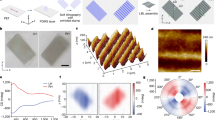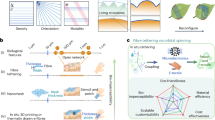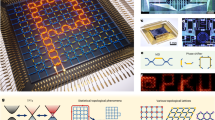Abstract
Field-emission displays contain materials that emit electrons when charged to a low (negative) potential; the electrons excite light emission from phosphor screens. These devices have the potential to provide flat-panel visual displays with good picture quality at low power consumption and low cost1. Field-emission devices at present use arrays of microfabricated tips as the emitting cathodes, but a potentially cheaper and simpler alternative is to use a thin-film cathode. This requires the identification of materials that will emit an appreciable electron current at low applied fields. Nitrogen-doped, chemical-vapour-deposited diamond films2 and amorphous carbon films3 have been explored for this purpose. The low electron affinity4, wide bandgap and excellent transport properties5 of some conducting organic polymers suggest that they might also provide good cathode materials. Here we demonstrate that this is so, reporting field emission from thin films of regioregular poly(3-octylthiophene) deposited on n-doped silicon, with indium tin oxide as the anode. The threshold fields that we measure for electron emission from these films are the lowest yet reported for any carbon-based material.
This is a preview of subscription content, access via your institution
Access options




Similar content being viewed by others
References
Chalamala, B. R., Wei, Y. & Gnade, B. E. FED up with fat tubes (review of current technology). IEEE Spectrum 35, 42–51 (1998).
Okano, K., Koizumi, S., Silva, S. P. & Amaratunga, G. A. J. Low-threshold cold cathodes made of nitrogen-doped chemical-vapour-deposited diamond. Nature 381, 140–141 (1996).
Amaratunga, G. A. J. & Silva, S. R. P. Nitrogen containing hydrogenated amorphous carbon for thin-film field emission cathodes. Appl. Phys. Lett. 68, 2529–2531 (1996).
Bredas, J. L. Relationship between band-gap and bond length alternation in organic conjugated polymers. J. Chem. Phys. 82, 3808–3811 (1985).
Nishino, H., Yu, G., Heeger, A. J., Chen, T.-A. & Rieke, R. D. Electroluminescence from blend films of poly(3-hexylthiophene) and poly(N-vinylcarbazole). Synth. Met. 68, 243–247 (1995).
Chen, T.-A., Wu, X.-M. & Rieke, R. D. Regiocontrolled synthesis of poly(3-alkylthiophenes) mediated by Rieze zinc: their characterisation and solid state properties. J. Am. Chem. Soc. 117, 233–244 (1995).
Fowler, R. H. & Nordheim, L. Electron emission in intense fields. Proc. R. Soc. Lond. A 119, 173–181 (1928).
Anderson, W. A. Role of space charge in field emission cathodes. J. Vac. Sci. Technol. 11, 383–388 (1993).
Lampert, M. A. & Mark, P. Current Injection in Solids 44–46 (Academic, New York, (1970)).
Robertson, J. Band model for electron emission from diamond and diamond-like carbon. Symp. Proc. MRS 422, 777–782 (1996).
Geis, M. W. et al. Nature 393, 431–435 (1998).
Acknowledgements
We thank N. Rupasinghe for assistance during the measurements, M. Chhowalla for discussions, and K. Molloy for technical assistance. We also thank the UK Engineering and Physical Research Council for financial support through studentships.
Author information
Authors and Affiliations
Corresponding author
Rights and permissions
About this article
Cite this article
Musa, I., Munindrasdasa, D., Amaratunga, G. et al. Ultra-low-threshold field emission from conjugated polymers. Nature 395, 362–365 (1998). https://doi.org/10.1038/26444
Received:
Accepted:
Issue Date:
DOI: https://doi.org/10.1038/26444
This article is cited by
-
Phenazine-containing poly(phenylenevinylene): a new polymer with impressive field emission properties
Journal of Polymer Research (2018)
-
Facile synthesis of cadmium sulphide-polyaniline (CdS-PANI) nanocomposite and its field emission investigations
Journal of Polymer Research (2015)
-
Carbon as an electronics material
Journal of Materials Science: Materials in Electronics (2006)
Comments
By submitting a comment you agree to abide by our Terms and Community Guidelines. If you find something abusive or that does not comply with our terms or guidelines please flag it as inappropriate.



